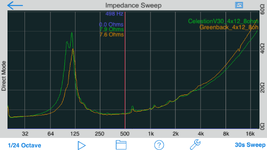It’s most easily understood by looking at the frequency plot of a speaker. Below is the plot of a greenback cab and v30 cab from the tgp thread linked earlier. These are 8 ohm cabs, see the ‘ohms’ on the right hand side of the scale.
View attachment 239105
When you measure an 8 ohm speaker with a multimeter you read a dc resistance of about 7.5 ohms since that is measured at 0hz (DC). However the actual resistance varies quite dramatically at different frequencies. The big low peak around 100hz is the resonant frequency of the speaker cone (cab internal volume also influences what frequency it is at). The rising impedence from about 1000hz up is due to the inductance of the voice coil. Each speaker and enclosure will result in a slightly different curve (where the low peak is, how tall and wide, how much the high frequency increase, etc) but every speaker will have that same general shape. Compare to the plot of the various settings of TAE, which doesn’t represent a real speaker load.
Many older load boxes modeled the high frequency impedence only with no low peak. This is because getting the low resonant peak right is expensive, and requires a pretty specialised capacitor (big, bipolar, very low esr) and inductor (big, high current capacity, as close to zero dcr as possible, no saturation). Easier now as those parts have gotten easier to make and cheaper.
But regarding sound, does it matter? Some people still use hotplates and they sound good to them, and they are much further off. Answer is, it depends.
With my recto in modern mode, there is no negative feedback in the power amp (power amp is ‘undamped’), so the output of the amp follows the impedence curve (which is why recto’s in modern mode have huge bass and treble response). Any change to the load has a large effect on the sound. When I built my DIY load I put a switch on it that shorts the reactive element and turns it into a resistive load. I flip that switch and the recto goes from sounding very punchy and big, to sounding like a practice amp in a cardboard box.
However with my jet city jca50, which has much more power amp negative feedback, there is almost no difference I hear flipping between reactive and resistive. Though if I run the presence high, it’s more noticeable (since turning up presence and depth decreases power amp damping in the high and low frequencies, respectively).
A bit of negative feedback, which linearises the amp output and makes it more stable and less sensitive to the load, and differences between loads become less noticeable.
Thank you for reading my blog

